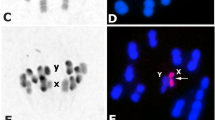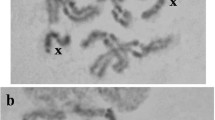Abstract
We have studied highly repeated DNA sequences of three subspecies ofM. fascicularis (M.f. philippinensis M.f. mordax, M.f. fusca) and of two subspecies ofM. mulatta (M.m. lasiotus, M.m. mulatta). Restriction patterns were obtained after digestion with 9 restriction endonucleases and evidenced after southern blotting and hybridization with Bam HI satellite DNA fragments fromM. fascicularis subspecies.
M. fascicularis andM. mulatta subspecies studied, present morphological differences but indistinguishable karyotypes: highly repeated DNA analysis, resulting in the same restriction patterns for all the restriction sites studied with highly repeated DNA probes characteristic of the threeM. fascicularis subspecies, gave arguments in favour of the high genetic homology ofM.f. philippinensis, M.f. mordax, M.f. fusca on one side, andM.m. lasiotus andM.m. mulatta on the other, which can be distinguished only on the basis of morphological criteria.
Similar content being viewed by others
References
Aleixandre C., Miller D.A., Mitchell A.R., Warburton D.A., Gersen S.L., Disteche C. and Miller O.J., 1987.p82H identifies sequences at every human centromere. Human Genetics 77: 46–50.
Arnason J. and Best P.B., 1991.Phylogenetic relationships within the Mysticeti (whalebone whales) based upon studies of highly repeated DNA in all extant species. Hereditas: 114: 263–269.
Baldini A., Miller D.A., Miller O.J., Ryder O.A. and Mitchell A.R., 1991.A chimpanzee derived chromosome-specific alpha satellite DNA sequence conserved between chimpanzee and human. Chromosoma 100: 156–161.
Baldini A., Miller, D.A., Shridhar V., Rocchi M., Miller O.J. and War D.C., 1993.Comparative mapping of a gorilladerived alpha satellite DNA clone on great ape and human chromosomes. Chromosoma 101: 109–114.
Baldini A., Kied, T., Shridhar V., Ogura K., D’Aiuto L., Rocchi M. and Ward D., 1993.An alphoid DNA sequence conserved in all human and great ape chromosomes evidence for ancient centromeric sequences at human chromosomal regions 2q21 and 9q13. Human Genetics 90: 577–583.
Beridize T., 1986.Satellite DNA. Springer-Verlag Berlin.
Brown F.L., Musich P.R., and Maio J.J., 1979.The repetitive sequence structure component alpha DNA and its relationship to the nucleosomes of the African green monkey. Journal of Molecular Biology 131: 777–779.
Choo K.H., Vissel B., Nagy A. and Kalitsis P., 1991.A survey of the genomic distribution of alpha satellite DNA on all human chromosomes, and derivation of a new consensus sequence. Nucleic Acid Research 19: 1179–1182
Crovella S., Ardito C., Montagnon D., Stanyon R. and Wolf C., 1992.Highly repetitive DNA patterns in humans and selected Catarrhine primates (Pan troglodytes, Cercopithecus aethiops, Macaca fascicularis). Folia Primatologica 58: 219–223.
Crovella S. and Rumpler Y., 1992.Confirmation of the specific status of Hapalemur aureus (Primates. Strepsirhini) by restriction genomic DNA banding patterns. Human Evolution 7(2): 63–67.
Crovella S., Montagnon D. and Rumpler Y., 1993.Highly repeated DNA analysis and systematics of the Lemuridae, a family of Malagasy Prosimians. Primates 34(1): 61–69.
Dandieu S., Ruffie J. and Lucotti G., 1985.Cartographie de restriction comparée de l’ADN satellite chez l’homme et le chimpanzee. Biochemical Systematics and Ecology 13: 71–75.
Donehower L., Furlong C., Gillespie D. and Kurnit D., 1980.DNA sequence of baboon highly repeated DNA: evidence for evolution by nonrandom unequal crossovers. Proceedings National Academy of USA 77: 129–13.
Dutrillaux B., Biemont M.C., Viegas-Pequignot E., and Laurent C., 1979.Comparison of the karyotype from Cercopithecidae: Papio papio; Papio anubis; Macaca mulatta; Macaca fascicularis. Cytogenetic Cell Genetic 23: 77–83.
Fanning T.G., Modi W.S., Wayne R.K. and O’Brien S.J., 1988.Evolution of heterochromatin-associated satellite DNA loci in fields and canids (Carnivora). Cytogenetics Cell Genetics 48: 214–219.
Fanning T.G., Suanez H.N. and Forman L., 1989.Satellite DNA sequences in the neotropical marmoset Callimico goeldi (Primates Platyrrhini). Chromosoma 98: 396–401.
Fooden J., 1982.Ecogeographic segregation of Macaque species. Primates 3 (4): 574–579.
Fooden J., 1991.Systematic review of Philippine Macaques (Primates, Cercopithecidae: Macaca fascicularis subspp.). Fieldiana: Zoology, N.S. 64: 1–44.
Hill W.C.O., 1953.Primates: Comparative Anatomy and Taxonomy. Vol. VII: Cercopithecidae. Edinburgh University Press, Edinburgh.
Jones K.W., 1978.Speculations on the functions of satellite DNA in evolution. Zoology Morphology and Anthropology 69: 143–171.
Jung K.Y., Crovella S. and Rumpler Y., 1992.Phylogenetic relationships among lemuriform species determined from restriction genomic DNA banding patterns. Folia Primatologica 58: 224–229.
Kurnit M., Maio J.J., 1973.Variable satellite DNAs in the African green monkey Cercopithecus aethiops. Chromosoma 45: 387–400.
Lima-De-Faria, Arnason U., Widegren B., Isaksson M., Essen-Moller J., and Jaworska H., 1986.DNA cloning and hybridization in deer species supporting the chromosome field theory. Biosystems 19: 185–212.
Maio J.J., Brown F.L. and Musich P.R., 1977.Subunit structure of chromatin and the organization of eukaryotic highly repetitive DNA: Recurrent periodicities and models for the evolutionary origins of repetitive DNA. Journal of Molecular Biology 117: 637–655.
Maniatis T., Fritsch E.F. and Sambrook J., 1982.Molecular Cloning. A laboratory manual (2nd edition). C. Nolan ed.) Cold Spring Harbor Laboratory Press. New York.
Miklos G.L.G., 1985.Localized highly repetitive DNA sequences in vertebrate and invertebrate genomes, pp. 241–321 in Molecular Evolutionary Genetics MacIntyre S.J. (ed.) Plenum Press, New York.
Miller D.A., Sharma D. and Mitchell A.R., 1988.A human derived probe. p82H, hybridizes to the centromeres of gorilla, chimpanzee and orangutan. Chromosoma 96: 270–274.
Modi W.S., Fanning T.G., Wayne R.K. and O’Brien S.J. 1988.Chromosomal localization of satellite DNA sequences among twenty two species of felids and canids (Carnivora). Cytogenetics Cell Genetics 48: 208–213.
Montagnon D., Crovella S. and Rumpler Y., 1993.Confirmation of the taxonomic position of Callimico goeldi (Primates. Platyrrhini) on the basis of its highly repeated DNA patterns. Compte Rendu de l’Academie des Sciences, Paris 316 (III): 219–223.
Musich P.R., Brown F.L. and Maio J.J., 1977.Subunit structure of chkromatin and the organization of eukaryotic highly repetitive DNA. Nucleosomal proteins associated with a highly repetitive mammalian DNA. Proceedings of the National Academy of Sciences of the United States of America 74: 3297–3301.
Musich P.R., Brown F.L. and Maio J.J., 1980.Highly repetitive component alpha related alphoid DNAs in man and monkeys. Chromosoma 80: 331–348.
Pike L.M., Carlise A., Newell C., Hong S.B. and Musich P.R., 1986.Sequence and evolution of rhesus monkey alphoid DNA. Journal of Molecular Evolution 23: 127–137.
Prassolov V.S., Kuchino Y., Nemoto K. and Nishimura S., 1986.Nucleotide sequence of the Bam HI repetitive sequence, including the Hind III fundamental unit, as possible mobile element from the Japanese monkey Macaca fuscata. Journal of Molecular Evolution 23: 200–204.
Rosemberg H., Singer M. and Rosemberg M., 1978.Highly reiterated sequences of Simian. Science 200: 394–402.
Rubin C.M., Deininger P.L., Houck C.K., and Schmidt C.W., 1980.A dimer satellite sequence in bonnet monkey DNA consists of distinct monomer subunits. Journal of Molecular Biology 136: 151–167.
Seuanez H.N., Forman L., Mayatoshi T. and Fanning T.G., 1989.The Callimico goeldi (Primates. Platyrrhini) genome: Karyology and middle repetitive (LINE-1) DNA sequences. Chromosoma 9: 389–395.
Stanyon R., Fantini C., Camperio-Ciani A., Chiarelli B. and Ardito G., 1988.Banded karyotypes of 20 Papionini special reveal no necessary correlation with speciation. American Journal of Primatology 16: 3–17.
Tautz D. and Renz M., 1983.An optimized freeze-squeeze method for the recovery of DNA fragments from agarose gels. Analytical Biochemistry 13: 14–19.
Thayer R.E., Singer M.F. and McCutchan T.F., 1981.Sequence relationships between single repeat units of highly reiterated African green monkey DNA. Nucleid Acid Research 9: 169–181.
Waye J.S. and Willard H.F., 1989.Concerted evolution of alpha satellite DNA. Evidence for species specifity and a general lack of sequences conservation among alphoid sequences of higher primates. Chromosoma 98: 273–279.
Willard H.F. and Waye J.S., 1987.Hierarchical order in chromosome- specific human satellite DNA. Trends Genetics 3: 192–198.
Author information
Authors and Affiliations
Rights and permissions
About this article
Cite this article
Crovella, S., Bigatti, M.P., Ardito, G. et al. The high genetic homology of threeMacaca fascicularis and twoMacaca mulatta subspecies on the basis of their highly repeated DNA restriction patterns. Hum. Evol. 9, 63–71 (1994). https://doi.org/10.1007/BF02438140
Received:
Accepted:
Issue Date:
DOI: https://doi.org/10.1007/BF02438140




